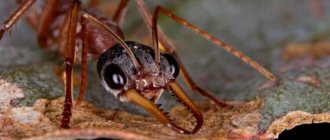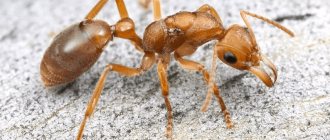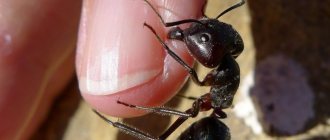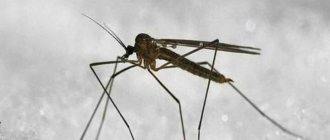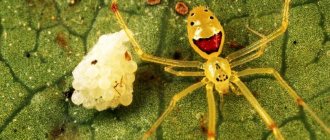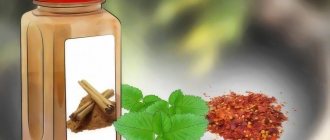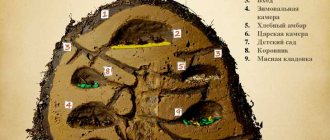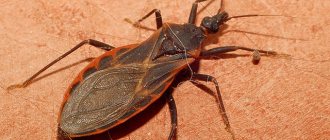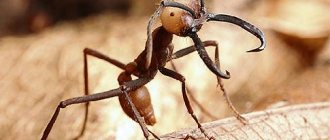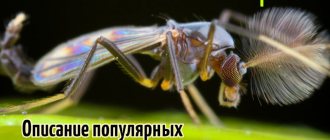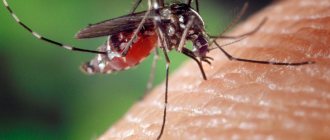18.01.2016
Ants are small, nimble insects that many people associate with hard work. Despite their small body size, these insects can lift a load several times their weight. There are many varieties of ants in nature. There are individuals that are completely harmless, but there are also dangerous ants that can harm human health. They will be discussed in this article.
- Varieties of dangerous ants
- Army ants (Siafu nomadic ants)
- Bullet Ants
- Bulldog Ants
- Fire Ant
- yellow ant
- Red Harvester
- The most dangerous ant in the world
Nomadic killer ants
Nomadic ants, which live in the rain forests of the New World, do not build traditional anthills. The life of stray ants of the genus Eciton consists of two phases, each of which lasts 2-3 weeks.
- Nomadic - when a colony of ecitons moves, migrates.
- Sedentary, during which the queen lays fertilized eggs. In a few days she can lay up to 300 thousand of them. At this time, the worker ants form a living anthill-bivouac from their own bodies.
Nomadic ant
Nomadic ants come in different sizes: workers - 2.5 mm, soldiers - up to 1.2 cm. The color is dark brown. The soldiers also have huge mandible jaws, long and curved at the ends. This gives them a very warlike and intimidating appearance. During migration, they are able to cover vast distances, literally sweeping away all living things on their way - after their invasion, there are no cockroaches, wasps, or even mice and rats left.
People prudently leave their homes so as not to inadvertently get in the way of ants. They are capable of painfully biting a person, and they try to get into a place near the cervical artery.
On a note! In Latin American countries, the invasion of nomadic ants is called marabunta and causes sacred awe among the population. In 1998, a horror film of the same name was made.
Benefits and dangers for humans
Residents of villages located in tropical forests are well aware of the capabilities of the ant horde. If their homes are in the path of insects, they take livestock and leave the village for a while. After the invasion of tropical nomads, all parasites in houses disappear. Flies, fleas, cockroaches, spiders, and rats are destroyed. Ants do not feed on plants, so fields are safely cleared of phytophagous pests.
The beneficial actions of stray insects do not exclude danger to humans. Once on the path of the colony, a person risks being bitten by hundreds of individuals. Nomadic ants do not bite their prey immediately. They crawl under clothes in large numbers and act on a signal. For people prone to allergies, such an attack ends in anaphylactic shock. Attacks on people and animals are rare. The main prey of ants is other insects. Tropical wandering ants clear forests of animal corpses and destroy sick and weak individuals.
Bulldog ants
Bulldog ants (Myrmecia gulosa) are one of the most dangerous creatures on the Australian continent. They have a rather bright and noticeable red color, and an impressive size - 2-3 cm.
This species is poisonous. A bulldog bite can provoke allergies, including anaphylactic shock; the affected area hurts for several days.
Colonies are quite small: from several dozen individuals, rarely up to several thousand. The female lays only 8 eggs at a time.
Bulldog
They were nicknamed bulldogs for their resemblance to dogs of this breed. Ants have a large square head with huge eyes located on the sides. The mandibles are long and serrated. They attack all living creatures that get in their way.
Unbelievable but true! In case of danger, the red bulldog ant can push off from the ground and jump up to 7.5 cm in height and 39 cm to the side.
Attacks on people
Due to the fact that these insects are inhabitants of warm tropical countries, the threat of attack is present all year round. Most often, local residents and tourists from Africa, America, and Australia are attacked. There are a huge number of attacks that have had serious consequences and deaths.
For example, there is a known case that occurred in America. An attack by poisonous ants occurred in a nursing home in 1999. The attack occurred while the elderly were resting in bed and could not have provoked the attack in any way.
Insects inflicted multiple bites on two elderly men. Despite the fact that the necessary medical actions were immediately taken and treatments were used, the first man died 5 days later, and the second died 14 days later.
Although they are inhabitants of natural environments, attacks in residential areas are regularly recorded. The consequences of attacks vary and are not always fatal. There is a known case when these insects attacked an infant; he fell into a coma, but fortunately survived. There was also an attack on a 2-year-old boy; an ant bit him on the cornea of the eye; in addition to emergency medical care, urgent surgery was also required.
Two elderly people could not survive the attack that took place at their home, and both died a week later. But there are cases where serious consequences were avoided after first aid was provided.
Each body reacts individually to the poison that enters the body. The same poison and in the same quantity can lead to death in one person, but not even cause complications in another. But you can’t hope that everything will work out; you need to take all possible measures to help protect yourself and prevent difficult situations.
If you are traveling to exotic countries, then go on excursions only with guides who are well aware of the possible dangers. In addition, it is recommended to use specialized protective equipment in the form of sprays and gels. Be sure to take antihistamines with you, which in case of a bite should be taken before receiving first aid.
Red fire ant
Historically, red fire ants (Solenopsis invicta) lived in Central America. This species is considered one of the most invasive (threats to biological diversity) in the Americas. Ants are omnivorous; they eat live and dead insects, small vertebrates, sweet plant juices, and honeydew. Size less than 1 cm, color brown, black.
Red fire ant
Over the past 20 years, ants with a poisonous sting have spread across all continents. A fire ant bite (sting) can be fatal to humans. The toxic substance released by these insects, called solenopsin, causes a burning sensation in humans. That's why fire ants got their name.
Ant bullet
The most dangerous ant in the world is rightfully considered to be an inhabitant of the rainforests of Central and South America - the bullet ant (Paraponera clavata). Scientists have proven that its poison (poneratoxin) causes local paralysis and unbearable pain that spreads in waves. The action of the toxin lasts 24 hours, so the insect in English literature received another name - ant 24 hours.
Bullet
Paraponeras are quite large insects, 1.8-2.5 cm long, brown in color. On average, about 1 thousand individuals live in colonies. They feed on everything and do not disdain dead animals. They will not specifically attack a person.
The reservoir of poison, to which the sting is attached, is shaped like a bullet, which is why the ants got their first name.
Interesting fact! The indigenous peoples of Central America use paraponer in a painful rite of passage for boys (a rite of passage from childhood to adult warriors).
Asian tailor ant
Tailor ants (Oecophylla smaragdina) are an amazing species that lives in the tropics and subtropics of South and Southeast Asia. Smaragdins have a green body and an average size of 1 cm.
Ants build their anthill nests in trees in a unique way; they prefer mango trees and ficus trees, because their leaves are dense and leathery. Working individuals pull together the leaves, stitching them together with cobwebs secreted by the larvae.
Asian tailor
A colony can occupy 10 trees and have up to half a million individuals.
The species is very aggressive and will attack anyone indiscriminately. Tailors have large mandibles and a sting with acid. The bite is painful for humans, but not fatal.
Interesting! Mango and citrus farmers prize smaragdins for their predatory tendencies. No insect pests of tropical gardens remain within the colony.
Ancestors of ants
According to Japanese researcher Evan Economo, worker ants evolved from flying insects. Their ancestors had a complex body structure. In particular, 50% of the volume of their chest was occupied by the muscles necessary for the movement of the wings. Because of this, other muscle groups necessary for the movements of the head, legs, abdomen and other parts of the body were pressed against the walls of the body and could not work at full strength.
Thanks to teamwork and strength, ants are able to build very tall structures.
But during evolution, some types of insects lost their wings and worker ants emerged. The space inside their chest became more open and the muscles inside were able to fully expand and reach their full potential. Body scans of the ants revealed that there are three groups of muscles inside their thorax. According to the author of the scientific work, Christian Peeters, they are located in a small space in an ideal ratio. Over the course of evolution, they clearly increased in volume and allowed insects to lift large loads.
Wingless wasps vaguely resemble ants
During the study, scientists also studied the body structure of wingless wasps, which also had winged ancestors. But they reacted differently to the loss of the ability to fly. While ants live in groups, wasps prefer to live alone. However, they cannot boast of the same physical strength as ants. What this is connected with is not yet clear to scientists. There is a high probability that ants have well-developed not only the muscles inside the thoracic region. In the course of subsequent scientific work, scientists intend to study the structure of the remaining segments of their body. They want to pay special attention to the design of their jaw and legs. In general, the study of ants is in full swing and soon we will learn even more interesting details about them.
Acacia ants
Symbiosis (mutually beneficial coexistence) has been recorded between the bull acacia and ants of the genus Pseudomyrmex ferruginea, living in the tropics of Central and South America. The female lays 15-20 eggs in a hollow tree thorn, and the colony gradually grows, populating the entire tree.
Worker ants catch insects attracted by the sweet sap of the acacia tree to feed the larvae. Adults feed on liquid and proteins produced by the plant in special capsules at the tips of the leaves. Ants also destroy the growth around the tree, protecting it.
The bite of the acacia ant is very painful, causing a burning sensation and throbbing pain.
Interesting fact! The ancient Mayans used the bites of acacia ants to treat depression.
Red harvester
Red bearded harvester ants (Pogonomyrmex barbatus) live in the United States and Mexico, preferring desert, arid areas. The size of the insects is 0.6-0.9 cm, the color is red-brown. They build huge anthills up to 4.5 m deep and up to 1 m in diameter, pouring a mound of small pebbles on top. They feed on grain, collecting and storing it in their pantries. One anthill can store up to 2 kg of grain.
Red harvester
The body of the harvester ant contains an alkaloid that serves as an alarm pheromone for other individuals. This alkaloid is highly toxic to humans. The pain from the bite of the red reaper is very, very strong and does not go away within 4 hours. The spread of the toxin through the lymphatic system causes severe allergies.
Consequences of the attacks
The poison that ants release when they bite is a highly toxic substance. It affects the human nervous system, which can lead to paralysis and death. One insect releases a small dose of poison, which most often is not fatal, but causes many complications.
Redness and swelling appear at the site of the bite, then the skin begins to become inflamed, severe itching, burning, pain appears, and swelling develops. The vascular system suffers, in a person who is prone to allergic reactions, the symptoms are dizziness, weakness in the body, headache, body temperature rises, nausea and vomiting appear, and disturbances in coordination of movements are observed.
This condition can occur in a person for several days. To get rid of symptoms, you need to take antihistamines as well as antiallergic medications.
When a person has a weak immune system, it is very difficult for the body to resist toxic poisons, especially when ingested in large quantities. Most often in such situations, muscle paralysis and disruption of the heart and lungs are observed.
It becomes difficult for a person to breathe, the larynx swells, and disturbances in blood pressure and heart rate are observed. If anaphylactic shock develops, it is necessary to give the person an antihistamine within the first 15 minutes after the bite, otherwise it will lead to death. Antihistamines can be replaced with anticonvulsants.
Yellow ants or anoplolepis gracilipes
Yellow crazy ants are small insects, only 4 mm long. They got their name for the chaotic movements they make in case of danger. Along with red fire ants, they are one of the most invasive insect species.
They are omnivores, eating insects, living and dead, and even half-decomposed carcasses of animals. They cause harm to agriculture because they promote the proliferation of sucking insects (aphids), from which honeydew is collected. Capable of creating supercolonies on an area of up to 100 hectares.
They do not have a sting, but when attacked, they inject large amounts of formic acid, which can cause blindness, especially in children.
Insect feeding
The favorite delicacy of ants are insects such as:
- wasp;
- bee;
- termite.
Nomadic ants of the African continent also feed on carrion, and it does not matter at all whether the corpse of an animal they eat is large or small. Stray insects mercilessly absorb everything that comes their way:
- different types of insects;
- snake;
- bird's nests;
- small invertebrates;
- amphibians.
The ants pierce the victim and inject it with a dose of a toxic, poisonous substance. Since the speed of insects is not too high (up to 20 km/h), weak, slow and wounded animals most often become their prey.
Siafu Ant
African carnivorous siafu ants live in the central and southern regions of the continent. Dorylus worker ants are small, 3-13 mm long, males ready for mating are 3 cm, females are up to 5 cm. A colony can number up to 20 million individuals.
Siafu
They lead a nomadic lifestyle, their movement speed is 20 m per hour. The soldiers have huge, menacing jaw-mandibles that are larger than their body size. In a year, the queen ant can lay up to 150 thousand eggs, from which new individuals will emerge.
Interesting fact! In the movie Indiana Jones and the Kingdom of the Crystal Skull (2008), the heroes encounter man-eating ants, and Dr. Jones calls them "siafu." This is fictional as the Dorilins are not native to South America, where the film is set, and are not actually killer ants.
An ant bite consists of two noticeable holes; it itself is quite painful, but it cannot cause death to a person.
Description of the species
The size of the colony can reach 22 million individuals. The largest is the uterus. Its length during the egg-laying period is 5 cm, which is a record among various types of ants. The queen is capable of producing a huge number of individuals, so the size of the colony does not decrease. Some insects die, but new nomadic ants immediately take their place.
The desire to migrate is observed only in two subspecies:
- Ecitoninae.
- Dorylinae.
When moving, ant soldiers are responsible for defense, so they are concentrated at the edges of the column. The inner part is occupied by workers who drag the future offspring and food.
Since the movement of the column occurs only during the day, at night the ants create a nest of living labor, the diameter of which is about a meter. Insects cling to each other with their paws, forming a secluded place for their queen and her offspring. To create such a nest, about 150 – 700 thousand individuals are used.
Migration does not last long, only a few days, after which the sedentary phase begins, which lasts from several weeks to 3 months. During this period, the queen lays a huge number of eggs (100 - 300 thousand) and by the end of the stay, larvae will appear from them. At the same time, adult individuals - adults - will emerge from the cocoons of the previous offspring.
Then the colony sets off. As soon as the larvae begin to pupate, it is time for the next stop.
